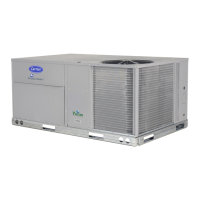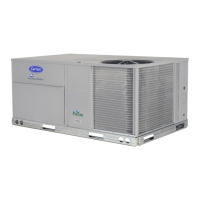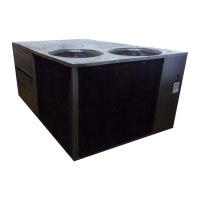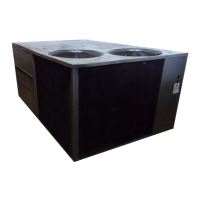95
VFD Diagnostics
The drive detects error situations and reports them using:
1. Green and red LEDs on the body of the drive (located under
the keypad)
2. Status LED on the control panel
3. Control panel display
4. The Fault Word and Alarm Word parameter bits (parameters
0305 to 0309)
The form of the display depends on the severity of the error. The user
can specify the severity for many errors by directing the drive to
ignore the error situation, report the situation as an alarm, or report the
situation as a fault.
Faults (Red LED Lit)
The VFD signals that it has detected a severe error, or fault, by:
1. Enabling the red LED on the drive (LED is either steady or
flashing)
2. Setting an appropriate bit in a Fault Word parameter (0305
to 0307)
3. Overriding the control panel display with the display of a
fault code
4. Stopping the motor (if it was on)
5. Sets an appropriate bit in Fault Word parameter 0305--
0307.
The fault code on the control panel display is temporary. Pressing
the MENU, ENTER, UP button or DOWN buttons removes the
fault message. The message reappears after a few seconds if the
control panel is not touched and the fault is still active.
Alarms (Green LED Flashing)
For less severe errors, called alarms, the diagnostic display is
advisory. For these situations, the drive is simply reporting that it
had detected something unusual. In these situations, the drive:
1. Flashes the green LED on the drive (does not apply to
alarms that arise from control panel operation errors)
2. Sets an appropriate bit in an Alarm Word parameter (0308
or 0309)
3. Overrides the control panel display with the display of an
alarm code and/or name
Alarm messages disappear from the control panel display after a
few seconds. The message returns periodically as long as the alarm
condition exists.
Correcting Faults
The recommended corrective action for faults is shown in the Fault
Listing Table 32. The VFD can also be reset to remove the fault. If
an external source for a start command is selected and is active, the
VFD may start immediately after fault reset.
To reset a fault indicated by a flashing red LED, turn off the power
for 5 minutes. To reset a fault indicated by a red LED (not
flashing), press RESET from the control panel or turn off the
power for 5 minutes. Depending on the value of parameter 1604
(FAULT RESET SELECT), digital input or serial communication
could also be used to reset the drive. When the fault has been
corrected, the motor can be started.
History
For reference, the last three fault codes are stored into parameters
0401, 0412, 0413. For the most recent fault (identified by
parameter 0401), the drive stores additional data (in parameters
0402 through 0411) to aid in troubleshooting a problem. For
example, a parameter 0404 stores the motor speed at the time of the
fault. To clear the fault history (all of Group 04, Fault History
parameters), follow these steps:
1. In the control panel, Parameters mode, select parameter
0401.
2. Press EDIT.
3. Press the UP and DOWN buttons simultaneously.
4. Press SAVE.
Correcting Alarms
To correct alarms, first determine if the Alarm requires any
corrective action (action is not always required). Use Table 33 to
find and address the root cause of the problem.
If diagnostics troubleshooting has determined that the drive is
defective during the warranty period, contact ABB Automation
Inc., at 1--800--435--7365, option 4, option 3. A qualified
technician will review the problem with the caller and make a
determination regarding how to proceed. This may involve
dispatching a designated service station (DSS) representative from
an authorized station, dispatching a replacement unit, or advising
return for repair.
Table32–FAULTCODES
FAULT
CODE
FAULT NAME IN PANEL DESCRIPTION AND RECOMMENDED CORRECTIVE ACTION
1
OVERCURRENT
Output current is excessive. C heck for excessive motor loa d, insufficient acceleration time ( para meters 2202
ACCELER TIME 1, default 30 seconds), or faulty motor, motor cables or connections.
2
DC OVERVOLT
Intermediate circuit DC voltage is excessive. Check for static or transient over voltages in the input power supply,
insufficient deceleration time (para meters 2203 DECE LER TIME 1, default 30 seconds), or u ndersized brake chopper
(if present).
3
DEV OVERTEMP
Drive heat sink is overh eated. Temperature is at or above 115_C (239_F). Check for fan failure, obstructions in the air
flow, dirt or dust coating on the heat sink, excessive ambient temperature, or excessive motor load.
4 SHORT CIRC Fault current. Check for short---circuit in the motor cable(s) or motor or supply disturbances.
5 OVERLOAD Inverter overload condition. The drive output current exceeds the ratings.
6
DC OVERVOLT
Intermediate circuit DC voltage is not sufficient. Check for missing phase in the input power supply, blown fuse, or
under voltage on main circuit.
7
Al1 LOSS
Analog input 1 loss. Analog input value is less than AI1 FLT LIMIT (3021). Check source and connection for analog
input and parameter settings for AI1 FLT LIMIT ( 3021) and 3001 AI<MIN FUNCTION.
8
Al2 LOSS
Analog input 2 loss. Analog input value is less than AI2 FLT LIMIT (3022). Check source and connection for analog
input and parameter settings for AI2 FLT LIMIT ( 3022) and 3001 AI<MIN FUNCTION.
9
MOT OVERTEMP
Motor is too hot, as estimated by the drive. Check for overloaded motor. Adjust the parameters used for the estimate
(3005 through 3009). Check the temperatur e sensors and Group 35 para meters.
10
PANE L LOS S
Panel communication is lost and either drive is in local control mode (the control panel displays LOC), or drive is in
remote control mode (REM) and is parameterized to accept start/stop, direction or reference from the control panel.
To correct check th e commun ication l ines and connections. Check parameter 3002 PANEL COMM ERROR,
parameters in Group 10: Command Inputs and Group 11:Reference Select (if drive operation is REM).
ComfortLINK v1.X

